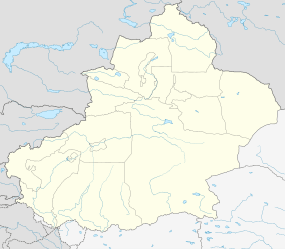Qiemo Town
| Qiemo چەرچەن 且末 | |
|---|---|
| County-level town | |
 Qiemo Location in Xinjiang | |
| Coordinates: 38°08′04″N 85°31′49″E / 38.13444°N 85.53028°ECoordinates: 38°08′04″N 85°31′49″E / 38.13444°N 85.53028°E | |
| Country | China |
| Province | Xinjiang |
| Prefecture | Bayingolin Mongol Autonomous Prefecture |
| Elevation | 1,252 m (4,108 ft) |
| Postal code | 841900 |
.png)
The oasis town of Qiemo or Cherchen (Uyghur: چەرچەن, Чәрчән, Chinese: 且末; pinyin: Qiĕmò; Uighur: Qarqan, also spelled Charchan) is the capital of Qiemo County, of the Bayingolin Mongol Autonomous Prefecture, Xinjiang, China is on the Qiemo River, at the foot of the Qilian Mountains, on the old Southern Silk Route. Anciently the town, and the kingdom it controlled, were frequently known as Shanshan.
Geography
Qiemo was strategically located at the junction of the main route from Dunhuang to Khotan via Jingjue or Cadota – the so-called “Niya site” north of modern Minfeng (also referred to as 'Niya', a route almost directly north to Korla, and another route which went south through the mountains, and around the southern shore of Qinghai Lake, and then on via Xining to eastern China.[1] Qiemo is 315 km east of Niya/Minfeng, 605 km east of Hotan, and 351 km west of Charklik/Ruoqiang Town along Highway 315.[2]
History
The Qiemo area has a very ancient history dating back to the Bronze Age. It is located along the ancient 'Jade Road' that traded with the earliest Chinese dynasties, and Bronze Age rock carvings were found south of town along another ancient trade route to what is now Tibet and a forgotten back door to central China.[2] Mummies dated to 1,000 BCE were discovered at the Zaghunluq site less than six km southwest of the city center of Qiemo. A particularly well-preserved one is known as the Cherchen Man.[3][4]
Qiemo existed as an independent kingdom during the Former Han Dynasty (123 BC to AD 23). It was described in the Hanshu, chapter 96A thus:
The seat of the government is the town of Ch'ieh-mo, and it is distant by 6820 li from Chang'an. There are 230 households, 1610 individuals with 320 persons able to bear arms. [There are the following officials:] the noble of Fu-kuo (support of the state), the leaders of the left and the right and one interpreter-in-chief ... There are grapes and various types of fruit. To the west there is communication with Ching-chüeh at a distance of 2000 li."— Hanshu, chapter 96a, translation from Hulsewé 1979.[5]
Interestingly, although the town is described in documents from the 1st century BC to the 9th century AD, the ancient site has not yet been discovered in spite of four major expeditions searching for it.[6]
The area was ruled as the kingdom of Calmadana during the earliest heyday of the Silk Road. Its fortunes have since ebbed and flowed, mainly with the popularity of the southern trade route. The Chinese Buddhist monk, Faxian, left a brief account of the country after his visit c. 399 AD, recorded that there were probably more than 4,000 monks in the country, all Hinayana. Song Yun passed through about 519, who recorded that the country had just been defeated by the Tuyuhun (Tibetan: Azha). It was sometimes abandoned, as when Buddhist monk Xuanzang passed through in the year 644, and when Marco Polo came by in 1273.
Transportation
- Qiemo is well-serviced with buses from the stainless-steel covered bus station just south of the city centre, heading both west to Hotan, east to Charklik / Ruoqiang and north to Korla.
- Qiemo Airport has flights, usually twice a week, provided by China Southern Airlines to and from Urumqi via Korla.
Footnotes
- ↑ Hill (2009), note 1.13, pp. 83–85.
- 1 2 A Tourism Guide to Cherchen / Qiemo, Xinjiang, China. Centralasiatraveler.com. Retrieved on 2011-03-12.
- ↑ Dolkun Kamberi (January 1994). "The Three Thousand Year Old Charchan Man Preserved at Zaghunluq :Abstract Account of a Tomb Excavation in Charchan County of Uyghuristan" (PDF). Sino-PlatonicPapers. 44.
- ↑ Mallory, J. P.; Mair, Victor H. (2000), The Tarim Mummies: Ancient China and the Mystery of the Earliest Peoples from the West, London: Thames & Hudson
- ↑ Hulsewé, A. F. P. (1979). China in Central Asia: The Early Stage 125 BC – AD 23: an annotated translation of chapters 61 and 96 of the History of the Former Han Dynasty. E. Brill, Leiden. pp. 92–93. ISBN 90-04-05884-2.
- ↑ Bonavia (2004), p. 330.
References
- Bonavia, Judy. (2004). The Silk Road: Xi'an to Kashgar. Revised by Christoph Baumer. Odyssey Publications.. ISBN 962-217-741-7.
- Hill, John E. (2009) Through the Jade Gate to Rome: A Study of the Silk Routes during the Later Han Dynasty, 1st to 2nd Centuries CE. BookSurge, Charleston, South Carolina. ISBN 978-1-4392-2134-1.
- Hulsewé, A. F. P. (1979). China in Central Asia: The Early Stage 125 BC – AD 23: an annotated translation of chapters 61 and 96 of the History of the Former Han Dynasty. E. J. Brill, Leiden.
External links
- Tourism Guide to Cherchen / Qiemo A Tourism Guide to Cherchen / Qiemo, Xinjiang, China. Centralasiatraveler.com. Retrieved on 2011-03-12.